
Thompson Center Firearms has always been the company that marches to the beat of a different trombone and in a good way. I have a Contender system from the early 1970s, I’ve worked with the Encore, Icon, Dimension, Venture, and Impact muzzleloader. All differ from competing products, from subtle to innovative, and all good performers. The Compass retains that tradition. The industry is trending toward value priced – high performance centerfire rifles; a $400 rifle that can shoot sub MOA. The Compass was examined within that context.
|
Thompson Center Compass |
|
| Manufacturer | Smith & Wesson |
| Point of Origin | Springfield, MA |
| Model # | 10058 |
| Caliber | 30-06 Springfield |
| Magazine Capacity | 5 |
| Barrel Length | 22″ |
| Twist Rate | 1:10″ 5R |
| Weight | 7.25 lbs. |
| Overall Length | 41.5″ |
| Stock | Black Composite |
| Checkering | Anti Slip Patterns |
| Hardware | Satin Blue |
| Pull | 13 3/8″ |
| Drop at Comb | 3/4″ |
| Drop at Heel | 1″ |
| Non-optical Sights | None |
| Trigger | Adjustable |
| Trigger Pull | 3.5-5 Lbs |
| Safety | 3 Position Swing |
| MSRP | $399 |
|
Weights and dimensions nominal |
|
The Compass is manufactured by Smith & Wesson, which makes sense as T/C is a Smith and Wesson company and Smith & Wesson has U.S. manufacturing capability. There are 10 models of Compass, each distinguished by chamber, capacity and barrel length.
| Chamber | Magazine Capacity |
Barrel Length |
Twist RATE |
Model |
|---|---|---|---|---|
| .204 Ruger | 5 | 22″ | 1:10″ | 10070 |
| 223 Remington/5.56 NATO | 5 | 22″ | 1:9″ | 10059 |
| .22-250 Remington | 5 | 22″ | 1:12″ | 10071 |
| .243 Winchester | 5 | 22″ | 1:10″ | 10072 |
| .270 Winchester | 5 | 22″ | 1:10″ | 10075 |
| 7MM-08 Remington | 5 | 22″ | 1:9″ | 10073 |
| 7MM Remington Magnum | 4 | 24″ | 1:10″ | 10076 |
| .308 Winchester | 5 | 22″ | 1:12″ | 10074 |
| 30-06 Springfield | 5 | 22″ | 1:10″ | 10058 |
| .300 Winchester Magnum | 4 | 24″ | 1:10″ | 10077 |
| Chamber | Current ” Twist Rates | ||||
|---|---|---|---|---|---|
| T/C Compass |
T/C Venture |
Rem M700 |
Ruger Hawkeye |
Win M70 |
|
| .204 Ruger | 10 | 10 | 12 | 12 | NA |
| 223 Remington/5.56 NATO | 9 | 12 | 12 | 9 | NA |
| .22-250 Remington | 12 | 12 | 14 | 10 | 14 |
| .243 Winchester | 10 | 10 | 9.12 | 9 | 10 |
| .270 Winchester | 10 | 10 | 10 | 10 | 10 |
| 7MM-08 Remington | 9 | 9 | 9.25 | 9.5 | 9.5 |
| 7MM Remington Magnum | 10 | 10 | 9.25 | 10 | 9.5 |
| .308 Winchester | 12 | 10 | 10* | 10 | 12 |
| 30-06 Springfield | 10 | 10 | 10 | 10 | 10 |
| .300 Winchester Magnum | 10 | 10 | 10 | 10 | 10 |
| *308 Tactical and varmint 1:12″ twist NA Not available in current bolt action products |
|||||
Rifling twist rates are interesting, some tighter… some less in comparison to competing brands and even a couple of differences from one of T/C’s other models, the Venture. Generally speaking, tighter twists stabilize heavier bullets more effectively, less tends to work best on lighter bullet weights. So where the Compass lists 5.56 NATO as well as 223 Remington and the Venture only lists the 223 Remington. This suggests that the Compass’s tighter twist is in anticipation of 5.56 NATO ammo with + 70 grain bullet weights. The 12″ 308 Winchester twist if often employed with Tactical and longer range varmint rifles where longer distances and mid range bullet weights would be the norm. The rifling is 5 R type; 5 grooves and lands with angular sides. Bullets are more uniformly deformed that straight sided lands and less fouling accumulates on the angular surfaces.
The subject firearm is chambered for the 30-06 Springfield; arguably one of the most flexible medium to big game cartridges of all time. The Thompson / Center Compass is fed by a flush fitting box magazine. The magazine is a self centering rotary type with a capacity of five rounds. It easily accommodates a maximum spec length of 30-06 Springfield round 3.340″ with approximately 0.200″ of room to spare. The magazine cannot be topped off without removal from the rifle.
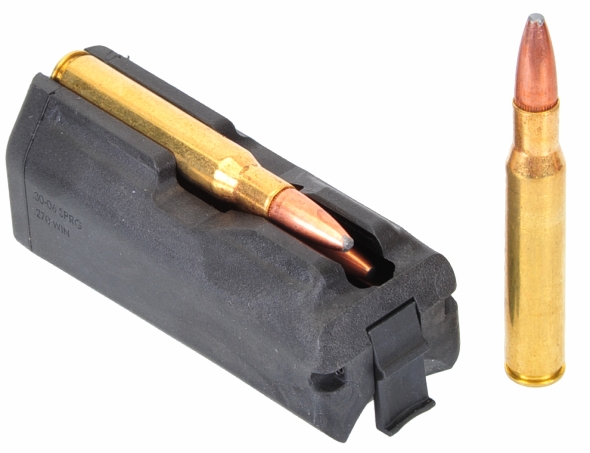
Some folk will gripe about the magazine’s poly construction, but structurally it is more sound than steel, it holds ammunition securely, it won’t rust, and it is less costly than steel. Additional magazines can be purchased directly through Thompson – Center customer service.
I wonder what ever happened to Michael Bolton?
The Compass’s bolt has a full diameter body; the circumference of the three lug bolt head and body are approximately 0.826″ in diameter. The full body gives the bolt a very solid and even stroke, the three lugs cut lift to just 60º which keeps the bolt handle away from scope eyepieces. The extractor is a spring loaded sliding type that resides on a lug face rather than inside the recessed bolt face. The ejector is a spring loaded plunger type. The bolt body fluting cuts down bearing surface and gives a place for François DeBris to accumulate without impeding bolt travel.
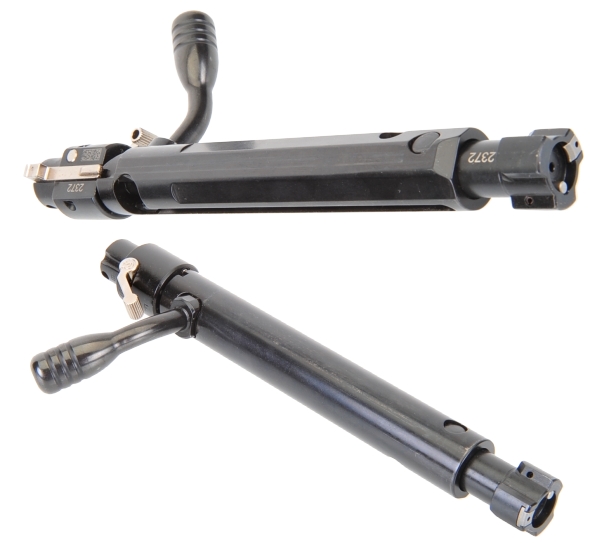
The Compass is a push feed system, rather than controlled feed, which is about as misleading on my part as the name on a piece of Congressional legislation. Push feed is also controlled, by the magazine feed lips and by the lead into the chamber. The bolt just pushes the cartridge along on its guided past. The Browning is not labeled a controlled feed rifle because it doesn’t have a big wonkin’, non-rotating claw extractor running the length of the bolt and because it doesn’t have that controlled feed speed bump to run over during the bolt stroke.
The Thompson – Center Compass is shipped with a threaded muzzle, 5/8″-24, and a thread protector. The thread is standard for a wide selection of brakes and suppressors that can reduce recoil and/or take the edge off of report. Pictured below, an SR7 fast-attach silencer made by Advanced Armament.
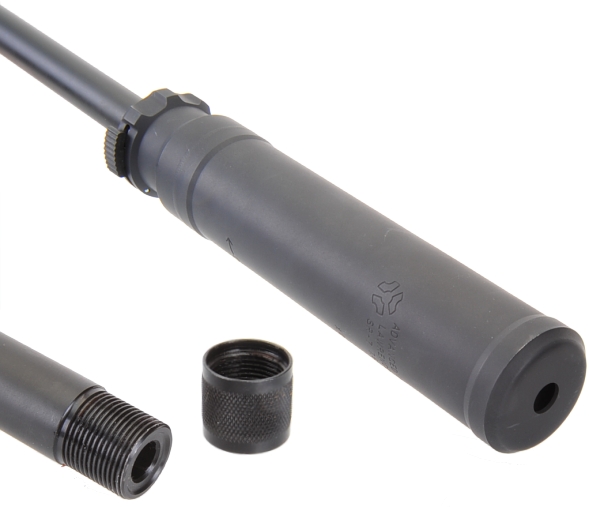
The 30-06 Springfield version barrel, like all other standard cartridge versions, is 22″ long. Magnum chambers get a 24″ barrel. All models have a free floating barrel and 5R rifling. By not having opposing lands, 5R rifling is said to cause less bullet deformity, and the angled versus straight cut land edges also reduced bullet deformation and reduce copper and lead accumulation in the bore. The Compass guarantee is minute of angle accuracy, stated as a 1″ 3 shot group with premium ammo.
The composite stock has stiffening ribs down the interior of the forearm and the stock is rigid and cleanly molded. Aluminum bushings molded into the stock are pretty close to pillar bedding. A wide, steel recoil just ahead of the forward stock fastener locks into a groove in the front receiver ring; assorted and sundry arrows point to the salient locations. The receiver walls are thick right on through to the receiver ring. This is a substantial rifle, with weight in the right places.
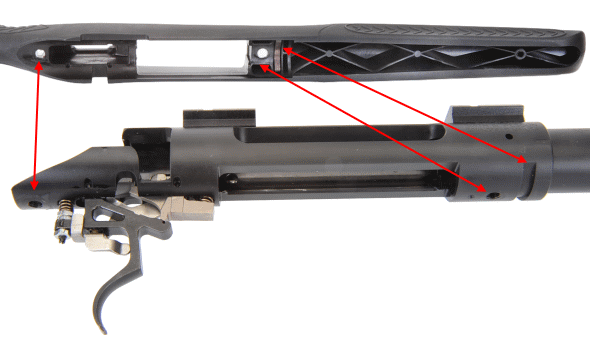
The T/C Compass’s trigger is adjustable between 3.5 lbs. and 5 lbs and it is also adjustable for overtravel. To adjust the trigger, the stock is removed, two Allen head fasteners, and then the adjusting nuts and center screw behind the trigger are set as defined clearly in the rifle’s manual. The trigger pull is… brief. No sensation of creep and let off is clean.
The stock’s lines are nice; a little sweeping lines thing going on. The forearm has finger grooves and a very effective anti slip pattern. The photo etch badging is tastefully done and impervious to cleaning agents and general firearm handling. Sling swivel studs and Weaver scope bases come premounted on the Compass. Combined with even low Warne rings, the bases they will clear a scope’s large eyepiece and a 40mm objective bell.
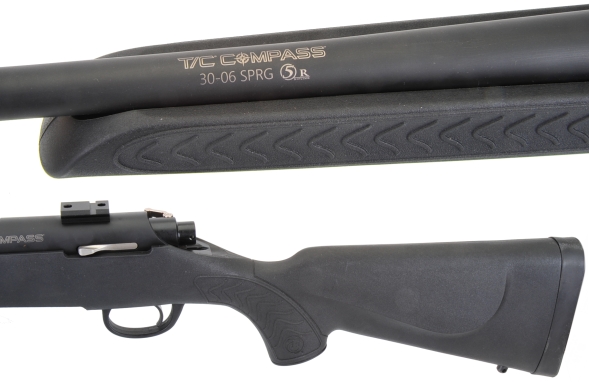
The bright piece below the rear scope base is the bolt stop; depressed to remove the bolt. The tight pistol grip radius works well for all occasions, which is more than I can say for myself. I am glad to see a straight comb and a cheek piece. Most companies drop the cheek piece on value priced firearms, as though modest discretionary spending doesn’t deserve good stock support.
Is it wing or swing?
I always refer to a safety that rotates about the firing pin axis as a wing safety, and safeties that travel fore and aft on the firing pin axis a swing safety… but that’s just me. The Compass swing safety is a 3 position affair. Forward = fire, middle is safe but no the bolt is not locked in battery and aft is safe with the bolt locked down.
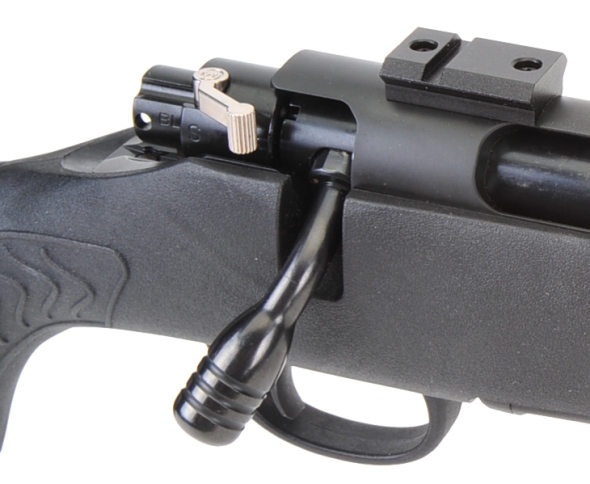
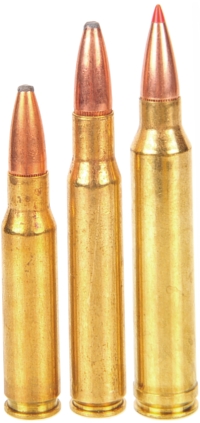 For me, and it could just be this example, but the forward and aft positions are very well defined and a snap to locate. Mid position is a little vague (gummy?) and the safety is a little noisy when moved forward to the fire position. I will readdress this observation after live fire when the rifle has been worked and fired a bit. The swept bolt handle is nice as something to hold onto and a swept angle that clears scopes and doesn’t snag on brush.
For me, and it could just be this example, but the forward and aft positions are very well defined and a snap to locate. Mid position is a little vague (gummy?) and the safety is a little noisy when moved forward to the fire position. I will readdress this observation after live fire when the rifle has been worked and fired a bit. The swept bolt handle is nice as something to hold onto and a swept angle that clears scopes and doesn’t snag on brush.
A 110 year old hot shot
Pictured with two other chamber selections available for the Compass: 308 Winchester, 30-06 Springfield and 300 Winchester Magnum. Just to hear individual cartridge fans scream, I will say that approximately 150 feet per second of velocity separates one from the next. I think most people would find the same if they ignored factory box labels and looked at chronograph readings.
I like the 30-06 because it has more potential than the 308 Winchester based on case capacity and long action association. I also like the 30-06 Springfield better than the 300 Winchester Magnum because it works well with a 22″ barrel, doesn’t smack me around with recoil and it will kill North American big game as well. Those are my stated preferences, but pragmatically speaking in regard to North American game, one can kill as well as the others under almost all circumstances with the right bullet selections.
Thompson – Centers Compass shows the way…
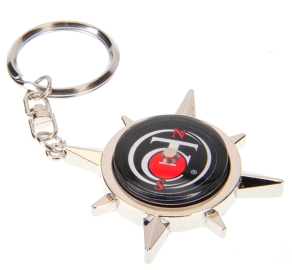
As a guy who worked for companies that exhibited at semiconductor tradeshows, I have a certain fascination with little giveaways like the Thompson – Center keychain with compass packed with each rifle. I know six people in the company’s marketing department tossed ideas around to come up with a little gimmick that would send just the right message while entertaining the customer. I think this was a good choice.
The Compass rifle is well made, nicely finished and devoid anything that signals a budget rifle. The choice of features, materials, finish, colors, and textures reflect exceptional aesthetic and functional design. In fact, I would go as far as to say, Thompson – Center might have set a new high water mark for value priced rifles.
I say “may have”, because for as good as the Compass looks, rifle and keychain, it is headed for the range with a scope and a pile of ammo and we’ll see how “good looking and well made” shoots.
Thompson Center’s Compass in 30-06 Springfield Part 1
Thompson Center’s Compass in 30-06 Springfield Part 2

Email Notification